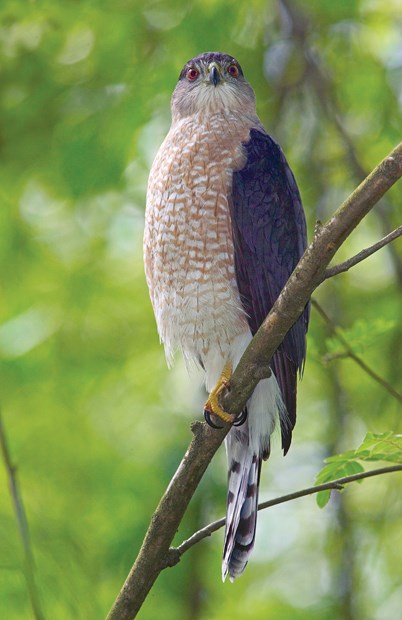Recently there was a great deal of excitement at the Conservation Area at Maplewood Flats when a northern goshawk was spotted.
This powerful hunter, largest of the accipiters ("bird hunters"), is seen on the North Shore with the Cooper's hawk and sharp-shinned hawk the other two species.
The goshawk is rare locally and is powerful enough to take a duck like the American wigeon. Very exciting.
The Cooper's hawk is a species commonly seen lurking near bird feeders - pigeons are a favourite prey. The smaller sharp-shinned hunts small birds, although it may also take a mouse from time to time - why pass up a good meal?
The goshawk sighting reminded me that winter on the North Shore is an excellent time to enjoy a diversity of raptors. Two exceptions are the turkey vulture and osprey, which are wintering in warmer places down south and we await their return.
Our local raptors fit neatly into the following groups: Falcons (peregrine, merlin, kestrel and gyrfalcon) Accipiters (northern goshawk, Cooper's hawk, sharp-shinned hawk) Buteos (red-tail hawk, roughlegged hawk) Harrier (northern harrier or marsh hawk) Eagles (bald and golden) Vultures (turkey) Shrikes (northern) - shrikes are actually predatory songbirds with the adaptations of raptors for hunting like sharp, powerful talons and a hooked bill.
The most recent edition of the Bird Checklist for the Conservation Area at Maplewood Flats lists a remarkable 10 species on the main list with one additional species on the Unusual Sightings' List - gyrfalcon.
The best way to start learning to identify raptors is by their shapes and behaviour. For example falcons have pointed wings and are built for speed. Buteos on the other hand have broad rounded wings, fan-shaped tails and are equipped for soaring. Accipiters, like the sharp-shinned hawk, with short wings and a long tail are skilled at fast attacks in bushy areas.
What should you watch for on a visit to the sanctuary and other habitats on the North Shore?
The two falcons most often seen locally are the peregrine falcon and the smaller merlin. Look for the former sitting high on power pilings or even perched on dolphins (several pilings bound together). The old (very old) name of the peregrine was "duck hawk" - a reference to its hunting habitats. I once saw one snatch a greater yellowlegs (mediumsized sandpiper) hit in mid-air, and another time a falcon took a green-winged teal (very small duck).
If you see a small dark falcon (remember those pointed wings) rocketing by, it will be a merlin. Look for side-burns on the faces of falcons.
Watch for Cooper's hawks perched in trees - note the black cap (beret on the adult).
Telling the 'sharpie' from the 'coop' is sometimes challenging, especially at a distance. Note the rounded tail base of the Cooper's versus the squared off tail of the 'sharpie.'
Of the soaring hawks, the red tail is the most common. Its colour is also highly variable (dark-light). In flight, dark bars on the wings, called patagials, are distinctive.
A bald eagle takes some four to five years to attain its adult white head and tail. It's tempting to call first or second year birds golden eagles. Get a good description and photo if you think you've spotted a golden.
Watch later in spring for the return of vultures and ospreys.
Look for raptors soaring on warm air currents (thermals).
Often there will be mixed birds, including ravens.
To help you enjoy raptors more, it should go without saying that a good pair of binoculars is essential. A spotting scope (kind that birders use) is a wonderful help in all kinds of birding. An up-to-date field guide or app is also essential for greater birding enjoyment. For best advice on optics and field guides see your local wild bird shop. Having the right stuff makes birding so much more enjoyable.
The feeding station at the Conservation Area at Maplewood Flats provided by Wild Birds Unlimited, continues to be a sensation. Golden-crowned sparrows, bushtits, spotted towhees, fox sparrows, common redpolls, and pileated woodpeckers are a few of the birds seen recently - and up close too. It's a great place for children to see birds in all their glory - again close up. And maybe a merlin, sharp-shinned hawk, or Cooper's hawk will add to the excitement.
Al Grass is a naturalist with Wild Bird Trust of British Columbia, which offers free walks at The Conservation Area at Maplewood Flats on the second Saturday of every month. The next walk will be Saturday, Feb. 13 at 10 a.m. Participants will be looking and listening for the birds of prey (hawks, eagles and if lucky, an owl) that spend the winter in the area. Meet at WBT's site office, 2645 Dollarton Hwy, North Vancouver. Walks go rain or shine. wildbirdtrust.org



